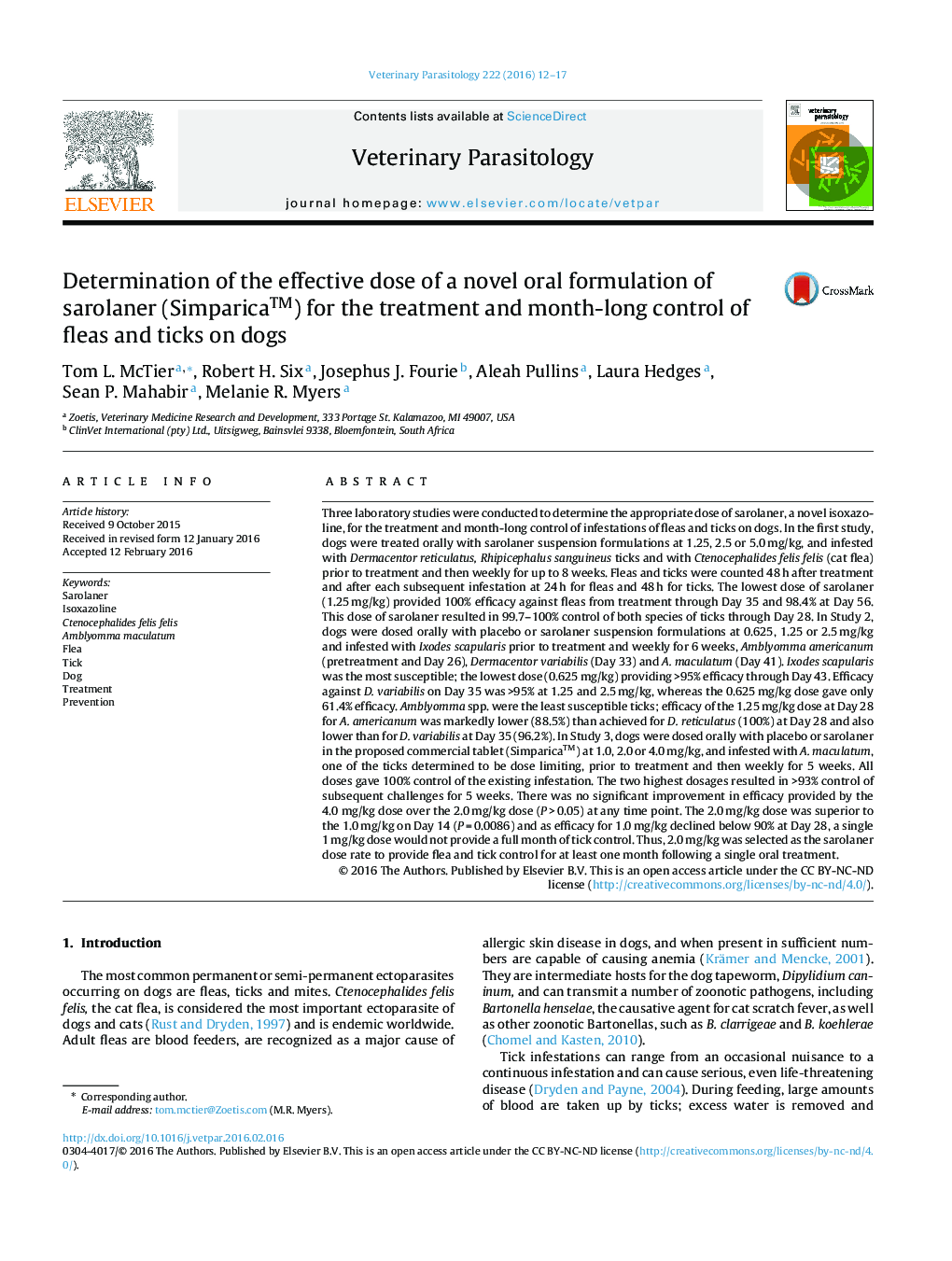| Article ID | Journal | Published Year | Pages | File Type |
|---|---|---|---|---|
| 2469833 | Veterinary Parasitology | 2016 | 6 Pages |
•Doses (0.625–5 mg/kg) of sarolaner were tested to assess efficacy against fleas and ticks for one month.•Fleas were susceptible and Amblyomma spp. were the least sensitive of the ticks tested.•Amblyomma maculatum was selected for dose determination.•2 mg/kg resulted in >90% control of A. maculatum for >4 weeks.•2 mg/kg was selected as the dose for one month control of fleas and ticks.
Three laboratory studies were conducted to determine the appropriate dose of sarolaner, a novel isoxazoline, for the treatment and month-long control of infestations of fleas and ticks on dogs. In the first study, dogs were treated orally with sarolaner suspension formulations at 1.25, 2.5 or 5.0 mg/kg, and infested with Dermacentor reticulatus, Rhipicephalus sanguineus ticks and with Ctenocephalides felis felis (cat flea) prior to treatment and then weekly for up to 8 weeks. Fleas and ticks were counted 48 h after treatment and after each subsequent infestation at 24 h for fleas and 48 h for ticks. The lowest dose of sarolaner (1.25 mg/kg) provided 100% efficacy against fleas from treatment through Day 35 and 98.4% at Day 56. This dose of sarolaner resulted in 99.7–100% control of both species of ticks through Day 28. In Study 2, dogs were dosed orally with placebo or sarolaner suspension formulations at 0.625, 1.25 or 2.5 mg/kg and infested with Ixodes scapularis prior to treatment and weekly for 6 weeks, Amblyomma americanum (pretreatment and Day 26), Dermacentor variabilis (Day 33) and A. maculatum (Day 41). Ixodes scapularis was the most susceptible; the lowest dose (0.625 mg/kg) providing >95% efficacy through Day 43. Efficacy against D. variabilis on Day 35 was >95% at 1.25 and 2.5 mg/kg, whereas the 0.625 mg/kg dose gave only 61.4% efficacy. Amblyomma spp. were the least susceptible ticks; efficacy of the 1.25 mg/kg dose at Day 28 for A. americanum was markedly lower (88.5%) than achieved for D. reticulatus (100%) at Day 28 and also lower than for D. variabilis at Day 35 (96.2%). In Study 3, dogs were dosed orally with placebo or sarolaner in the proposed commercial tablet (Simparica™) at 1.0, 2.0 or 4.0 mg/kg, and infested with A. maculatum, one of the ticks determined to be dose limiting, prior to treatment and then weekly for 5 weeks. All doses gave 100% control of the existing infestation. The two highest dosages resulted in >93% control of subsequent challenges for 5 weeks. There was no significant improvement in efficacy provided by the 4.0 mg/kg dose over the 2.0 mg/kg dose (P > 0.05) at any time point. The 2.0 mg/kg dose was superior to the 1.0 mg/kg on Day 14 (P = 0.0086) and as efficacy for 1.0 mg/kg declined below 90% at Day 28, a single 1 mg/kg dose would not provide a full month of tick control. Thus, 2.0 mg/kg was selected as the sarolaner dose rate to provide flea and tick control for at least one month following a single oral treatment.
